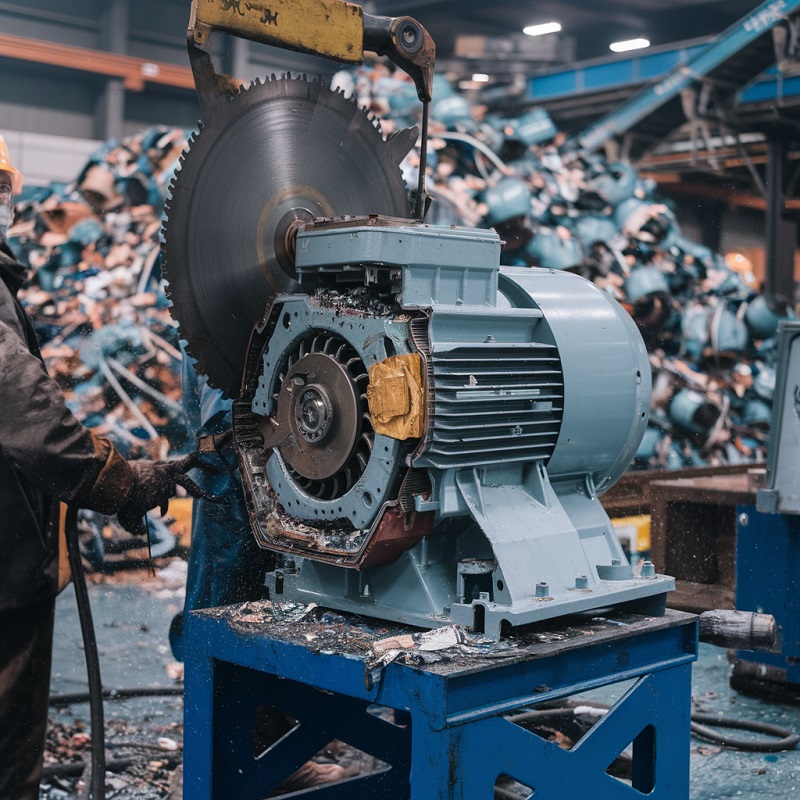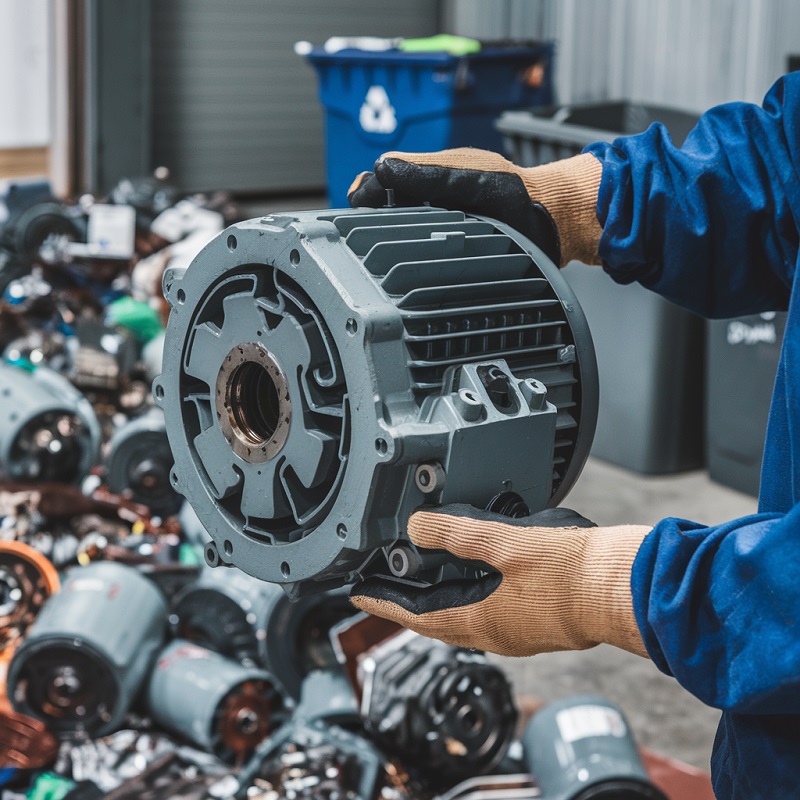Electric motor recycling is a smart and green way to dispose of old motors instead of leaving them in landfills. By recycling electric motors, you help save materials and reduce environmental harm. This guide will cover how electric motor recycling works, why it’s important, and how anyone can get involved in this simple process.
What is Electric Motor Recycling?
Electric motor recycling is dismantling electric motors to recover copper, steel and aluminum. These materials can be used to make new products. Motors are found in many common devices such as appliances, fans, pumps and tools. Recycling ensures their valuable parts are reused, not wasted and conserved when they break or get old.
Why Recycle Electric Motors?
Recycling electric motors for:
- Environmental protection: When motors are thrown away they can release harmful chemicals into the environment.
- Resource conservation: Motors contain copper, steel and aluminum that can be used again in new products.
- Energy savings: Recycling copper uses less energy than mining new resources.
- Economic benefits: Recycling electric motors not only helps companies save costs but also creates jobs in the recycling industry, contributing to the local economy and job market.
How Electric Motor Recycling Works?
Collection of Motors
The first step in electric motor recycling is to collect old or damaged motors. This can be done through recycling programs, scrap yards, or directly from manufacturers. Your role in this process is crucial, as every motor you recycle contributes to a healthier environment.
Disassembly of Motors
Next the motors are disassembled. This is often done by machines or by hand. The motor is broken into parts to separate materials like copper, steel, and aluminum.
Sorting of Materials
Once the motor is taken apart the materials are sorted. Copper wires, steel frames and aluminum components are collected separately.
Recycling of Metals
After sorting the metals are sent to recycling facilities. Here, they are melted and refined so they can be used to manufacture new products.
Reuse of Materials
The recycled metals are then used to make new products. Copper, for example, is used in new electrical wiring; steel and aluminum can be turned into car parts or construction materials.
Use of recycled copper
Recycled copper from electric motors is highly valuable and can be reused in a variety of products and industries. Here are some common items and applications made with recycled motor copper:
1. Electrical Wiring and Cables
Copper is an excellent conductor of electricity, so a significant portion of recycled copper is used to make electrical wiring and cables for homes, buildings, appliances, and vehicles. This helps reduce the need for newly mined copper.
2. New Electric Motors and Generators
The copper recovered from old motors can be reused to manufacture new motors, transformers, and generators. Since copper is essential for efficient electrical conduction, it remains a key component in these devices.
3. Electronics
Copper is widely used in circuit boards, connectors, and other electronic components. Recycled copper from electric motors is often repurposed into electronic devices like smartphones, computers, and televisions.
4. Plumbing
Recycled copper is frequently used to make pipes, fittings, and valves for plumbing systems. Copper’s durability and resistance to corrosion make it a perfect material for plumbing applications.
5. Copper-Based Alloys
Recycled motor copper can be mixed with other metals to create alloys like brass and bronze. These alloys are used in products such as musical instruments, coins, decorative items, and industrial machinery components.
6. Automotive Parts
Copper is essential in many automotive parts, especially in the electrical systems of cars, including alternators, starters, and electric vehicle components. Recycled copper helps meet the demand for these parts while reducing resource extraction.
7. Renewable Energy Systems
Wind turbines and solar panels also utilize copper in their wiring and components. Recycled copper is crucial in the green energy sector, helping to build more sustainable energy systems.
8. Art and Jewelry
Some artists and jewelers use recycled copper for creating sculptures, jewelry, and other decorative items. Copper’s rich color and malleability make it a popular material for creative projects.
By reusing copper from recycled electric motors, industries help conserve natural resources, reduce energy consumption, and lower environmental impacts.
Types of Electric Motors Recycled
There are different types of electric motors and each one can be recycled:
- AC Motors
Found in home appliances like refrigerators and air conditioners. AC motors are recyclable and contain copper and steel.
- DC Motors
Used in cars, power tools and some household devices. DC motors contain copper and other metals that can be recycled.
- Large Industrial Motors
They are used in factories and can be big. They contain a lot of valuable materials so they should be recycled.
Benefits of Electric Motor Recycling
- Reduces Landfill Waste
One of the biggest benefits of electric motor recycling is that it reduces the amount of waste sent to landfills. Instead of motors piling up, their parts can be used again.
- Conserves Natural Resources
Recycling electric motors means fewer new materials need to be mined. This helps conserve natural resources like copper, which is used in many everyday products.
- Saves Energy
Producing new metals from recycled materials takes much less energy than mining and processing new raw materials. This means electric motor recycling helps save energy and reduce pollution.
- Creates Jobs
The recycling industry creates jobs in local communities. Collecting, processing, and selling recycled materials require workers, which helps boost the economy.
How You Can Recycle Electric Motors
If you have old electric motors lying around, it’s easy to get them recycled:
- Check with Local Recycling Centers
Many local recycling centers accept electric motors. Call ahead to see if they take them and if there are any special rules for dropping them off.
- Use a Scrap Yard
Scrap yards are always looking for valuable materials like copper and steel. You can take your old motors to a scrap yard, and they may even pay you for the materials.
- Contact an E-Waste Recycler
Some e-waste recycling companies specialize in recycling electronics and their components. Many of these companies offer drop-off services or even pick-up for large items.
- Partner with Manufacturers
Some manufacturers offer recycling programs for their products. If your motor came from a specific brand, check if they have a take-back program.
Example of an Electric Motor Recycling Plant
A great example of a plant specializing in electric motor recycling is Sims Metal Management, one of the world’s largest metal and electronics recyclers. Sims Metal operates numerous facilities globally, and its business includes recycling electric motors as part of its overall scrap metal recycling services.
Sims Metal Management – Electric Motor Recycling
Plant Functions and Operations:
Sims Metal Management processes millions of tons of scrap metal yearly, including electric motors from appliances, vehicles, industrial machinery, and other electronic devices. The electric motors they handle contain valuable metals like copper, aluminum, and steel.
Here’s how Sims Metal typically handles electric motor recycling:
- Collection: Sims collects electric motors from individuals, businesses, manufacturers, and other industries. Customers can drop off motors or Sims may partner with companies to collect large quantities of scrap motors.
- Sorting: The electric motors are sorted by type and size, allowing the plant to optimize the process for separating valuable materials.
- Disassembly: Motors are broken down into their individual components, often through automated shredding processes. This makes recovering copper, steel, and aluminum from the motors easier.
- Material Separation: Advanced technologies such as magnetic separation, eddy currents, and air classification systems are used to separate ferrous (iron-containing) metals from non-ferrous metals like copper and aluminum.
- Melting and Refining: Once separated, the metals are sent to smelting facilities where they are melted down and refined for reuse in new products.
Sims Metal’s recycling of electric motors is important for the economy and the environment.
Revenue:
Sims makes money from the resale of recycled metals, especially copper. Copper from electric motors is the most valuable material in the recycling market. We also make money from steel and aluminum which is used in construction and automotive manufacturing.
Supply Chain:
Sims Metal supplies raw materials to construction, automotive and electronics manufacturing industries. The recycled copper and steel from electric motors are critical for these industries to reduce their reliance on new metal mining.
Overall:
Sims Metal Management’s recycling of electric motors is a win-win: it stimulates economic activity, reduces waste, conserves resources and protects the environment. Recycling is a big deal and can provide businesses with valuable materials while keeping less bad stuff out of the environment.
FAQs: Electric Motor Recycling
- What types of motors can be recycled?
All motors can be recycled, AC motors, DC motors, large industrial motors. Each contains copper, steel and aluminum.
- Can I make money from recycling electric motors?
Yes, many recycling centers and scrap yards will pay you for the metals in electric motors, especially copper.
- Is electric motor recycling good for the environment?
Yes, recycling electric motors is good for the environment. Reduces landfill waste, conserves natural resources, saves energy and reduces pollution.
- What happens to the metals after recycling?
The metals are melted down, refined, and used to make new products like cars, construction materials, and electrical wiring.
- Can motors be reused instead of recycled?
Sometimes motors can be repaired and reused. But if a motor is beyond repair, recycling is the way to go.
Conclusion: Why Electric Motor Recycling Matters
Electric motor recycling is a simple way to help the environment and reduce waste. Recycling electric motors recovers valuable materials, saves energy, and reduces environmental impacts. Whether you’re an individual with an old motor or a business looking to recycle in bulk, recycling electric motors is easy to do.




